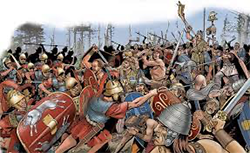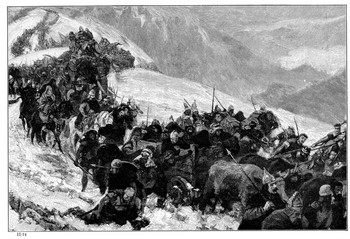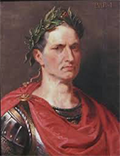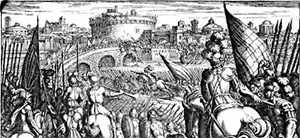The Gauls
Part 2: Conflicts with Rome
Gallic peoples also expanded into the Balkans and Greece, leading a force into the Greek mainland twice in the early 3rd Century B.C. In 279 B.C., Gallic armies under the warriors Bolgios defeated a Macedonian army, killing its king, Ptolemy Keraunos. Not having enough warriors to occupy any of the surrounding cities, the Gauls lived off the countryside. They retreated in the face of a larger Macedonian army, after Sosthenes led that army to victory. Another man named Brennos (not the one who had sacked Rome) led a second Gallic invasion of Greece the following year. Advancing to Thermopylae, they were part of history repeating itself, as they were initially stymied by a Greek coalition at the famous "Hot Gates" but, like the Persians two centuries, before, traveled a treacherous mountain pass that enabled them to encircle the Greek army and defeat it. A desperate Greek defense at Delphi proved successful and turned the tide, also killing the Gallic leader Brennos. From that point on, the Greeks pushed the Gauls back again and again, finally forcing them out altogether. 
The Romans did not consider the Po River plains to be part of Italy. Nonetheless, the Gallic sacking of Rome greatly upset the Romans. They eventually conquered the area surrounding the Po, from the Appenines to the Alps, and named it Cisalpine Gaul (meaning "Gaul on this side of the Alps"). The culmination of a few decades of skirmishes was the titanic Battle of Telamon (225 B.C.), which pitted Gallic forces numbering 70,000 against Roman forces numbering 107,000. The Celts had more forces on horseback, but the Roman infantry advantage was 2–1. The Gauls, after ravaging Etruria and defeating the Romans at Faesulae, had marched toward Rome. The two large armed forces met at Telamon, and the Romans turned the tide eventually, rolling up the Gauls after a two-pronged attack closed up the ranks. Gallic dead numbered 40,000; captured were 10,000. Roman armies completed the conquest of Cisalpine Gaul in 222 B.C.  Three years later, the Carthaginian general Hannibal attacked Saguntum, a Roman city in Hisptania. This trigged the Second Punic War. When Hannibal led his troops over the Alps and into the Po Valley, he did so by going through territory settled by a number of Gallic tribes. Hannibal thought that he could count on these people, so recently defeated by the Romans, as allies. He got a mixed response and had to work hard just to make it through Gallic territory. Once through, Hannibal, gained a large number of Gallic warriors as allies. After Hannibal's victory at the Trebia River, Rome abandoned Cisalpine Gaul altogether. Significantly, warriors from Gaul played a part in the devastating Battle of Cannae in 216 B.C. The defeat of Hannibal in 202 B.C. gave the Romans freedom to reoccupy Cisalpina Gaul and they did so, retaking their colonies Cremona and Placentia in the process. Roman retribution against the Boii in 191 B.C. was particularly harsh. A coalition of Gauls and Ligurians attacked the Greek colony of Massalia (Massilia) in 154 B.C., and Rome answered Massalia's call for help. Rome prevailed and, as a result, took control of the surrounding area, in 121 B.C. making it a province and establishing the colony Narb. The people who lived there called it Provincia, and the French version of that Latin word is Provence. Gallic warriors joined the Germanic Cimbri in a war against Rome in the early 2nd Century B.C. The coalition was successful against Rome for a time. The Roman dictator Gaius Marius, after he had conquered Numidia, led a Roman force north and, at Vercellae in 101 B.C., defeated the Cimbri and Gauls. 
Fifty years later, a large Roman force under Julius Caesar (left) arrived, beginning what ended up being the subjugation of all Gaul. In 62 B.C., the Arverni had attack another Gallic tribe, the Aedui, which at the time had an alliance with Rome. The Romans were content to let Gauls fight amongst themselves at that point; but when the Helvetii, a large Germanic tribe, marched across Gaul, Caesar himself got involved. After a number of attempts at battle and keeping the peace, the two armies clashed in the Battle of Bibracte and the Romans were victorious. The Romans again intervened in Gallic fighting in 57, marching against the Belgae. That tribe, allied with the Nervii, gave the Romans great pause, but Caesar again was successful and became more involved in controlling Gaul. While Caesar and several legions were invading Britain (once each in 55 B.C. and 54 B.C.), Gallic tribes on the mainland were busy harrying Roman emplacements. Ambiorix, leader of the Eburones, led an uprising that was successful for a time. Caesar himself took charge of the Roman forces and, in 53 B.C., put down the Eburone revolt. The following year saw the rise of Vercingetorix. Next page > Vercingetorix > Page 1, 2, 3, 4 |
|
Social Studies for Kids
copyright 2002–2025
David White



 Significantly for Roman history, a number of Gallic tribes settled in the Po Valley in the 4th Century. It didn't long for the two peoples to come into conflict, particularly since the Gauls made a habit of battling with Rome's neighbors the
Significantly for Roman history, a number of Gallic tribes settled in the Po Valley in the 4th Century. It didn't long for the two peoples to come into conflict, particularly since the Gauls made a habit of battling with Rome's neighbors the 
